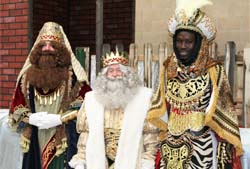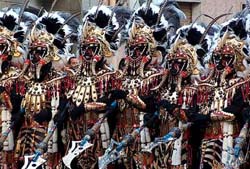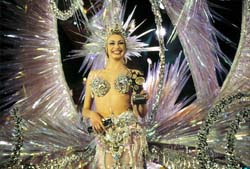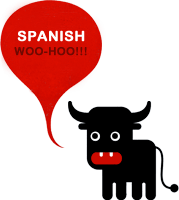Celebrating in Spain
'Navidad' - Christmas

One of the biggest differences you will notice about Christmas in Spain is that much of what we class as Christmas day activities, i.e. the presentation of gifts takes place on the 6th of January rather than the 25th December. This is because the Magi (Three Wise Men) are considered by Spanish children as those who bear the gifts, in keeping with the nativity story. Instead, Spanish families celebrate Christmas together on Christmas Eve and then a number of families will attend midnight mass. It isn’t until after midnight when the feast is enjoyed with all family members sitting and celebrating together. On Christmas day most families attend church service and take part in festivities with Christmas celebrations continuing up to the 6th of January when children hope to receive gifts from the Three Wise Men.
In terms of traditional Christmas food, Spain has definitely got its fair share. El turrón is one of the country’s favourites: nougat mixed with almond, sugar and honey which come in two forms; duro (hard) and blando (soft). El Roscón de Reyes is also a well-loved speciality usually eaten on the 6th January. It is a large, donut shaped cake covered with glaze and sweets but the most exciting part is what is baked inside. A small figurine of Jesus or a coin and a dried bean will already be inside the cake, after sharing out the slices among the family, whoever eats the slice containing the figurine or coin is said to have good luck for the rest of the year and whoever gets the bean must pay for the roscón!
'Nochevieja' - New Year
Like many countries across the world, New Year is an event to celebrate amongst friends and family and Spain is no different. It is traditional for families to countdown the final seconds of New Year via the clock at Puerta Del Sol in the centre of Madrid either in person or via the TV.
Traditionally a grape should be eaten at every chime of the clock at midnight in order to ensure good luck for the coming year. You can find out more about this strange tradition here.
'Pasqua' - Easter
Also known as Holy Week – ‘Semana Santa’ is one of Spain’s most important religious festivals, centred on the biblical story of the resurrection of Jesus. The festival is celebrated in slightly different ways depending on the city or town however the main events include sombre parades through the main streets with men carrying massive statues representing biblical scenes. Not only are these floats extremely heavy, but they are ornately carved and lavishly decorated; creating a scene completely unlike any you will have seen before.
Another eerie sight that appears amongst the parades are the hundreds of cloaked penitents or nazarenos, their costumes resemble those worn by the Klu Klux Klan but this is the only similarity that they share, don’t worry! The most striking part of the robes that they are wearing is called ‘Capirotes’ which is the name for the pointed hat and face covering. The nazarenos usually follow each float during the parade carrying long candles and are sometimes barefoot.
'Moros y Cristianos' - Moors & Christians
 This popular Spanish festival is based on the battles that took place between the Moorish and Christian tribes in Spain during the Reconquista. During the festival, battle reconstructions are organised on a large scale as well as parades through the streets in order to signify the drama of the actual event.
This popular Spanish festival is based on the battles that took place between the Moorish and Christian tribes in Spain during the Reconquista. During the festival, battle reconstructions are organised on a large scale as well as parades through the streets in order to signify the drama of the actual event.
Usually two different reconstructions take place: the first is when the Moors win, representing the powerful Moorish reign over much of Spain during the 8th – 15th centuries. In the second battle, the Christians win and celebrations begin in representation of the Moors final defeat and the re-conquest of Spain. In true Spanish fashion, fireworks and festivities usually end the festival on a high note.
San Fermín
San Fermín is the kind of festival that the Spaniards are famous for; colourful, loud and completely crazy. From the 6th to the 14th of July, Pamplona in Navarre is buzzing with activity and fiesta, the beginning of which is marked by a rocket launch at midday on the 6th. The following day a procession takes place through the city centre during which a gigantic statue of the Saint Fermín is carried through the streets surrounded by dancers.
The most famous part of the festival is the running of the bulls which involves hundreds of people dressed in white costumes with a red neckerchief running directly in front of a herd of bulls. Narrow streets and slow runners make the event almost unbearable to watch yet hundreds of Spaniards are quite willing to risk their necks in front of a large number of rather angry bulls; I doubt there’s another event which gets the adrenaline pumping more than this!
Carnival

Colourful, exciting and mad; Carnival is one of Spain’s most vibrant festivals celebrated just before lent in various areas across the country. Glittering costumes and feathery headdresses are just the start of the events; processions, entertainment and music fill the streets and each town and city has their own personal way to celebrate.
In parts of Catalonia, for example, boiled sweets rain from the sky in their millions (Vilanova i la Geltrú), street concerts take place every night (Lleida) and stuffed donkeys are hung from towers (Solsona). Elsewhere in Spain, street parties are enjoyed by locals sporting multi-coloured wigs and outfits in the style of a circus-come-masquerade-ball event. Historically the festival is of Christian decent said to loosely translate as ‘Farewell to meat’ explaining why it takes place just before Lent during which it is traditionally prohibited to eat meat.
La Tomatina
Finally the most famous, and hilarious Spanish festival, the idea of throwing tons of tomatoes at each other in the street sounds ludicrous to all non-Spaniards! Buñol in Valencia, Spain is the location for this madness, where, on the last Wednesday of August, over 40 tons of tomatoes are thrown and dropped on locals and tourists lining the streets. It’s no wonder that people travel from all over the world to experience one of Spain’s most famous events, where it’s normal to finish the day having your entire body hosed down by the fire department. Just don’t forget your goggles!









